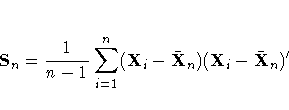Chapter Contents
Previous
Next
|
Chapter Contents |
Previous |
Next |
| Specialized Control Charts |
| See SHWT2 in the SAS/QC Sample Library |
In many industrial applications, the output of a process characterized by p variables that are measured simultaneously. Independent variables can be charted individually, but if the variables are correlated, a multivariate chart is needed to determine whether the process is in control.
Many types of multivariate control charts have been proposed; refer to Alt (1985) for an overview. Denote the i th measurement on the j th variable as Xij for i = 1,2, ... ,n, where n is the number of measurements, and j = 1,2, ... ,p. Standard practice is to construct a chart for a statistic T2i of the form

![{\bar{X}}_j = \frac{1}n \sum_{i=1}^n X_{ij}, &
X_i = [ X_{i1} \ X_{i2} \ \vdots...
..., &
{\bar{X}}_n = [ {\bar{X}}_{1} \ {\bar{X}}_{2} \ \vdots \ {\bar{X}}_{p}
]](images/saceq43.gif)

In this example, a multivariate control chart is
constructed using a beta distribution for T2i.
The beta distribution is appropriate when the data
are individual measurements (rather than subgrouped
measurements) and when ![]() and
and ![]() are estimated from the data being charted.
In other words, this example illustrates a start-up phase
chart where the control limits are determined from the data being
charted.
are estimated from the data being charted.
In other words, this example illustrates a start-up phase
chart where the control limits are determined from the data being
charted.
|
Chapter Contents |
Previous |
Next |
Top |
Copyright © 1999 by SAS Institute Inc., Cary, NC, USA. All rights reserved.